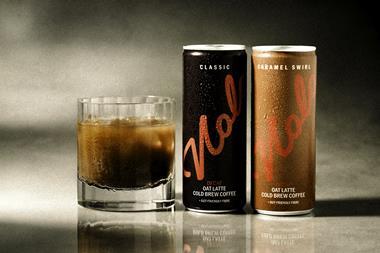There’s more money in speciality so big hitter Twinings is under pressure from standard brands’ lines and own label
With volume growth rates as high as 30.8% [green tea, ACNielsen Scantrack June 25, 2005] and higher margins than the heavily discounted standard tea sector, it is little wonder speciality, fruit and herbal variants are generating so much interest.
“The really big sectors of growth are green teas, decaf and fruit and herb,” says Premier Foods’ general manager Sarah Robinson.
“And organic is growing strongly too, although that’s from a very small base.”
Twinings remains dominant, with 67% of speciality teas (Earl Grey, Darjeeling, etc) 29.4% of green teas and 58.4% of fruit and herb infusions [ACNielsen August 6, 2005].
But mainstream tea brands, faced with a steep decline in standard tea, have been
muscling in, and own label has now taken more than a quarter of speciality sales and 14.5% of infusions. Also gaining sales are specialists such as organic brand Clipper and the health-focused Dr Stuart’s herbal range.
As part of its Partners for Growth category management scheme for convenience retailers, Unilever advises smaller retailers to “keep your fixture neat, tidy and separated into the four product groups - normal, fruit & herbal, green and speciality”.
And Twinings’ customer marketing controller Christine Edwards says there’s an equal need for clarity in the multiples. “We did some segmentation work on specialities last year and are just about to do the same with infusions. We found that while there are some people who only drink speciality, the majority drink mainstream tea and then, from time to time, choose to trade up. And we’d made it quite difficult for them to shop the fixture.”
According to Edwards, consumers were often unfamiliar with flavours such as Golden Tipped Assam or Lady Grey, and didn’t know what to expect. “They were telling us: ‘It’s a bit expensive, so there’s a risk if I don’t like it.’ We had not made it easy for people to experiment.”
Twinings has already re-segmented its speciality range into distinct ‘taste pillars’ - classics, light classics, aromatics, etc - grouped together using similar pack colours. It is also promoting one hero or lead blend in each segment, such as English Breakfast, to give consumers a feel for how other varieties in the same colour-coded segment will taste. A similar exercise is under way in infusions and green teas.
According to brand consultant Chris Grantham at Dragon Brands, fruit and
herbal teas are polarised between those with functional health benefits, such as camomile to aid sleep, and taste propositions, driven largely by fruit tea.
“A problem has been that the taste offers haven’t really been good enough or the health benefits broad enough to attract the young, experimental tea drinker, which is what the market really needs to grow value.”
Functionality won’t be enough to attract younger, more demanding consumers, Grantham says. Upcoming functional ingredients are likely to be presented with “much softer, less specific ‘health’ messages wrapped around a more indulgent, organoleptic experience”.
This is reflected in the emerging Dr Stuart’s fruit and herb tea brand, where popular varieties include Detox, Tranquillity, Wild Fennel, Skin Purify and Diet Aid.
Boaters, meanwhile offers varieties including Wake Up and Slumber Time in its instant teas range, but is trying to reintroduce the “theatre” of loose tea making with its A-Z range: 26 products ranging from Assam Golden Flowery Pekoe to Zariza Samovar tea.
“We want to promote the brewing and tasting of exotic and classic varieties to consumers who may not have sampled the ‘tea’ experience,” says general manager Chris Tarling. “I may be wrong, but I believe that 20 to 30-year-olds have no idea what a teapot looks like.”
With volume growth rates as high as 30.8% [green tea, ACNielsen Scantrack June 25, 2005] and higher margins than the heavily discounted standard tea sector, it is little wonder speciality, fruit and herbal variants are generating so much interest.
“The really big sectors of growth are green teas, decaf and fruit and herb,” says Premier Foods’ general manager Sarah Robinson.
“And organic is growing strongly too, although that’s from a very small base.”
Twinings remains dominant, with 67% of speciality teas (Earl Grey, Darjeeling, etc) 29.4% of green teas and 58.4% of fruit and herb infusions [ACNielsen August 6, 2005].
But mainstream tea brands, faced with a steep decline in standard tea, have been
muscling in, and own label has now taken more than a quarter of speciality sales and 14.5% of infusions. Also gaining sales are specialists such as organic brand Clipper and the health-focused Dr Stuart’s herbal range.
As part of its Partners for Growth category management scheme for convenience retailers, Unilever advises smaller retailers to “keep your fixture neat, tidy and separated into the four product groups - normal, fruit & herbal, green and speciality”.
And Twinings’ customer marketing controller Christine Edwards says there’s an equal need for clarity in the multiples. “We did some segmentation work on specialities last year and are just about to do the same with infusions. We found that while there are some people who only drink speciality, the majority drink mainstream tea and then, from time to time, choose to trade up. And we’d made it quite difficult for them to shop the fixture.”
According to Edwards, consumers were often unfamiliar with flavours such as Golden Tipped Assam or Lady Grey, and didn’t know what to expect. “They were telling us: ‘It’s a bit expensive, so there’s a risk if I don’t like it.’ We had not made it easy for people to experiment.”
Twinings has already re-segmented its speciality range into distinct ‘taste pillars’ - classics, light classics, aromatics, etc - grouped together using similar pack colours. It is also promoting one hero or lead blend in each segment, such as English Breakfast, to give consumers a feel for how other varieties in the same colour-coded segment will taste. A similar exercise is under way in infusions and green teas.
According to brand consultant Chris Grantham at Dragon Brands, fruit and
herbal teas are polarised between those with functional health benefits, such as camomile to aid sleep, and taste propositions, driven largely by fruit tea.
“A problem has been that the taste offers haven’t really been good enough or the health benefits broad enough to attract the young, experimental tea drinker, which is what the market really needs to grow value.”
Functionality won’t be enough to attract younger, more demanding consumers, Grantham says. Upcoming functional ingredients are likely to be presented with “much softer, less specific ‘health’ messages wrapped around a more indulgent, organoleptic experience”.
This is reflected in the emerging Dr Stuart’s fruit and herb tea brand, where popular varieties include Detox, Tranquillity, Wild Fennel, Skin Purify and Diet Aid.
Boaters, meanwhile offers varieties including Wake Up and Slumber Time in its instant teas range, but is trying to reintroduce the “theatre” of loose tea making with its A-Z range: 26 products ranging from Assam Golden Flowery Pekoe to Zariza Samovar tea.
“We want to promote the brewing and tasting of exotic and classic varieties to consumers who may not have sampled the ‘tea’ experience,” says general manager Chris Tarling. “I may be wrong, but I believe that 20 to 30-year-olds have no idea what a teapot looks like.”



















No comments yet